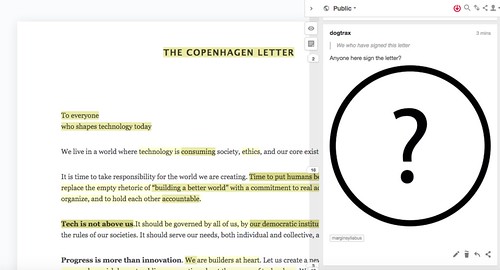
Close Open flickr photo by Kaarina Dillabough shared under a Creative Commons (BY-SA) license
An interesting, and quite challenging, discussion unfolded on Twitter this past weekend that centered on the concepts of crowd annotation tools and content that can found on the open web. Tools like Hypothesis (which I use pretty regularly) allow you to annotate most websites and blogs, creating a digital margin side area for discussion. The benefits seem obvious to me: crowd annotation provides a space for engaging group discussions about specific texts and ideas, generating new and expanded understanding of the digital pieces that we are reading.
But the provocative question was raised by a writer with a large audience (one whom I read regularly and support via Patreon): Who owns that original text (that content which is being annotated in the digital margins) and how much say do they have over whether the annotation should even happen in the first place? This particular writer used a web script to shut down Hypothesis and other annotation tools at their site.
It’s not a clear-cut issue, at least in my mind, and a long discussion on Twitter between nearly a dozen people (including the writer, for a bit, before they became angered by the discussion and asked to be left alone) revealed the complexities of ownership of content, and what relationship the writer has with their readers when posting something to the open web.
I find myself appreciating a writer’s desire to be able to control what is being done at their website or blog, and understand the sense of being concerned about what people are doing in the margins of an original text. Sure, comments potentially do open up that discussion, too, but let’s face it, the comment sections of many sites — particularly those run by women with strong opinions — often get overrun by those with nothing better to do in their petty lives than leave vicious comments and provocative, and perhaps profane, words.
The worry is that someone writing in the digital margins will be malicious, too, and the writer would have little (at this time, anyway) recourse. This is a legitimate concern, as any perusal of comments at YouTube will tell you. (Hypothesis is close to adding some new functions for flagging content and has been mulling over this very concept of writer’s rights). To be honest, I have yet to come across anything like that in Hypothesis.
Still, as much I can see the point of protest, another part of me (maybe the naive part of me, that voice that says look to potential and possibilities with digital writing) thinks, if you post something to the world via the Web, you can expect (hope/intend) that maybe someone will want to read what you wrote and maybe react to your words. Why else post your writing if not to engage a reader? (The argument against this viewpoint is that people do the writing, not technology, and writers should not be held hostage to the potential aspects of technology. Or something like that.)
I believe tools like Hypothesis give space for collaborative discussions, allowing the margins of the text to come alive with conversation and questions and associative linking that extends the thinking of the original writer. It empowers the reader, although perhaps that empowerment comes at the expense of the writer’s authority over their own words at that point.
Personally, I use Hypothesis to closely read online texts, to examine and think, and to bounce ideas off the text to others in the margins, who help push my own thinking forward or force me to re-examine my beliefs and ideas. Your text, if posted to the web, can become a source of inspiration for me, and others. That’s a real gift to your readers.
Clearly, not everyone thinks this way.
What do you think?
Who owns the text once a writer makes it public on the Web?
Peace (thinking),
Kevn
PS — There were other nuances to the Twitter discussion that I did not capture here — including the right to be forgotten in a connected world; obligations and compacts (or not) to readers who financially support the writer who is not wanting to be annotated; and what role a text has in the public sphere.
PSS — I purposely did not name the writer because they clearly were upset that their decision was being questioned, and I did not want to make their situation any worse. Besides, the individual case here is less important than the larger discussion.





